Seeing penguins in the wild is a rare thrill because these adorable flightless birds aren’t found in many places in the world. Antarctica may be the location that people most often associate with penguins, but various species of penguins can also be found in unexpected parts of South America, Africa, and Australia.
Though penguins are designed to survive cold weather, they can live in some reasonably hot areas as long as the ocean currents are cool. That’s why some kinds of penguins live in countries like Namibia, Peru, and even Ecuador, home to the Galapagos penguin, the only penguin living north of the equator.
This article gathers lesser-known places worldwide where you can visit penguins in the wild without too much difficulty. The entries were chosen for their accessibility. Each destination can be reached by car or on a guided boat tour from a nearby town. The list includes places where tourists can view various kinds of penguins, including Humboldt, king, African, Galapagos, Magellanic, and rockhopper penguins.
Stony Point Nature Reserve, South Africa
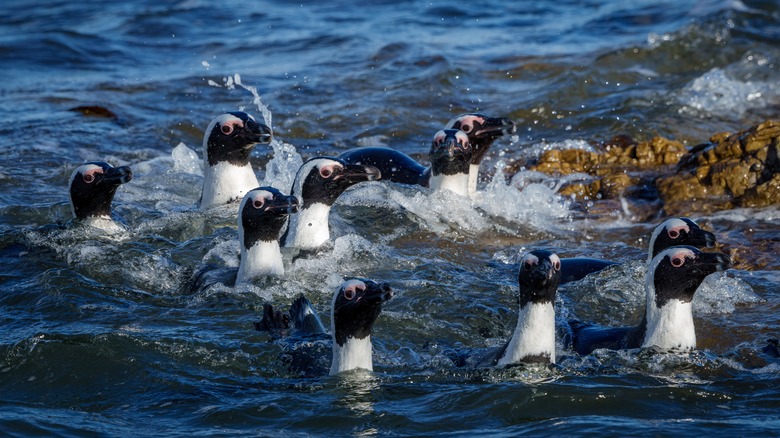
Stony Point is one of a handful of spots where you can see African penguins on the shores of South Africa. Located less than 90 minutes from Cape Town by car, the protected reserve sits on the site of an old whaling station from the mid-1900s.
The penguins here are small, about 2 feet tall. According to Penguins International, African penguins are recognizable by the black stripes that run up the sides of their bellies and the patch of pink skin above their eyes. They remain endangered due to limited areas of suitable habitat and a decline in the population of sardines, one of their favorite foods. The park has created several artificial burrows made of cement and fiberglass, which aid in breeding by providing shaded spaces for eggs and chicks.
Getting to the town of Betty’s Bay is easy via provincial route 44, and admission to the preserve currently costs just R30 or about $1.65. Visitors to Stony Point can use the elevated boardwalk to walk along the shore without disturbing the penguins. Look for other fabulous creatures on the rocks and sand, including girdled lizards, four species of cormorant birds, and rock hyrax, small mammals that look like giant guinea pigs.
Boulders Beach, South Africa
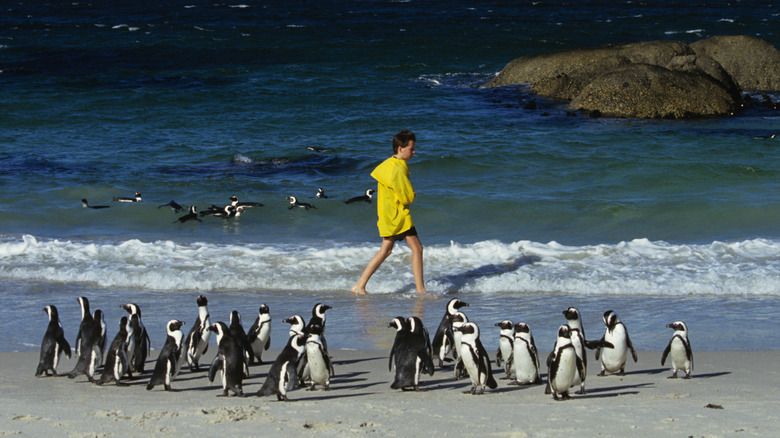
Interested in swimming with wild penguins? There’s no better place than Boulders Beach in South Africa. Part of Table Mountain National Park, the beach is a protected area that welcomes tourists. The African penguins here are unbothered by human presence, so you can walk down to the beach and even swim in the water with penguins floating just a few feet away. The beach is considered a safe place to hang out since granite boulders protect the beach from large waves. Some even call it one of the best beaches in the world.
Some penguins create nests right on the beach, digging holes in the sand and covering them with sticks. Others nest in the thick vegetation a bit farther from the beach. The park has boardwalks that pass through these areas, allowing visitors to see hundreds of penguins up close. Don’t try to touch them, though — penguin beaks are razor-sharp.
Boulders Beach is easily reachable by car or as part of a guided tour from Cape Town. You’ll pay a small entry fee at the visitor center, equivalent to less than $10, as of 2024. You can visit year-round, though Cape Town Tourism advises that summer (December to March) is best if you want to spend time in the water. The water tends to be chilly most of the year – that’s why penguins like it here!
Halifax Island, Namibia
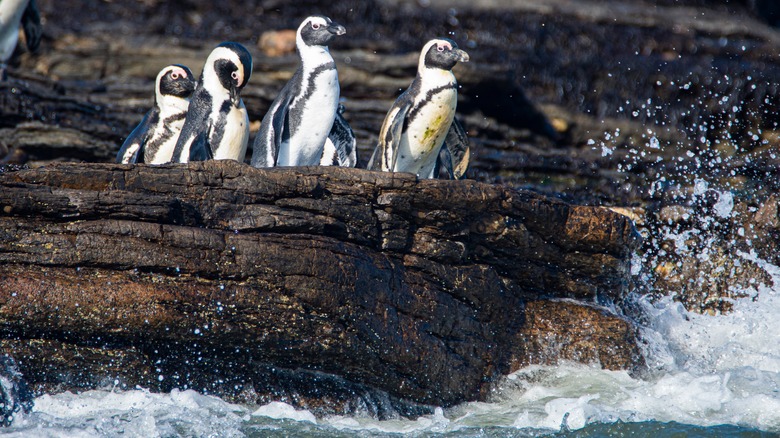
Lukas_Vejrik/Shutterstock
Many people overlook Namibia as a place to see penguins. The country in southern Africa is known more for its expansive deserts, the rhinos and lions of Etosha National Park, natural wonders such as Fish River Canyon, and the colony of Cape fur seals on the Skeleton Coast. Less known is that Namibia harbors African penguins on three islands in the Atlantic Ocean.
Halifax Island is not far from the mainland. Some folks have posted Google reviews mentioning that it’s possible to drive to the coast and see the Halifax Island penguins from shore with the help of binoculars or a good zoom camera. If you’re willing to pay for a closer look at the penguins, head to the German colonial town of Lüderitz and join the catamaran tour that does a loop around the island.
Halifax Island was once covered in guano or accumulated bird excrement, as the guano was valuable as fertilizer and thus collected by humans. The African penguins that used to make their nests in guano caves now have to live on the open rocks, which makes them more vulnerable to the weather and predators. The Maryland Zoo, which partners with penguin conservation organizations in Namibia, estimates that Namibia currently has about 5,000 pairs of nesting penguins.
Galápagos Islands, Ecuador
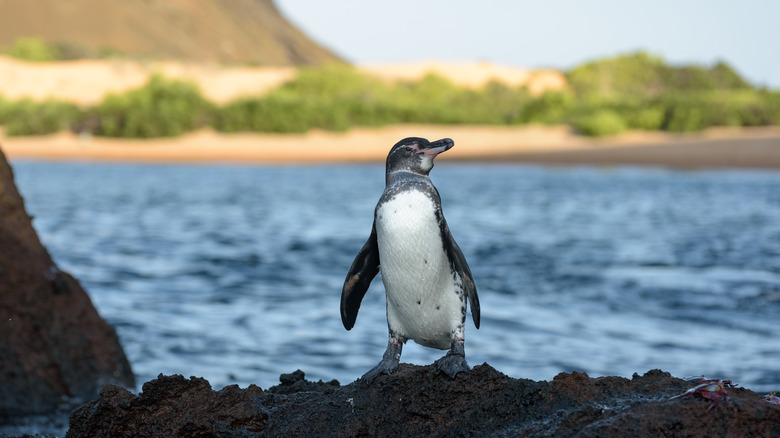
nodrama_llama/Shutterstock
Galápagos penguins are the only penguins to live north of the equator. The American Bird Conservatory notes that Galápagos penguins stand less than 20 inches tall, and their small stature allows them to find shelter from the sun’s intense rays in cracks or caves in the rocks. These birds only live on the Galápagos Islands, the isolated volcanic islands off the coast of Ecuador. Though the Galápagos are nearly 600 miles from the mainland, they’re a popular travel destination. Tourists come to see the giant tortoises and other unusual species described by Charles Darwin, whose visit in 1835 helped shape his theory of evolution.
Many companies offer Galápagos cruises and daily boat tours from several islands. About 95% of all Galápagos penguins live on Fernandina and Isabela, the two westernmost islands. While these islands aren’t the most popular, some cruises and tours stop here, giving travelers a glimpse of both penguins and tortoises. The Galápagos Islands are also a surprisingly good destination for solo travelers.
The World Wildlife Fund says Galápagos penguins are endangered, with fewer than 2,000 remaining in the wild. Even though the islands are protected as part of the Galápagos National Park and Marine Reserve, pollution and climate change remain threats to the survival of this species. The penguins hunt for fish in the cool ocean currents that sweep through this region, which means rising water temperatures can diminish the amount of available prey.
Ballestas Islands, Peru
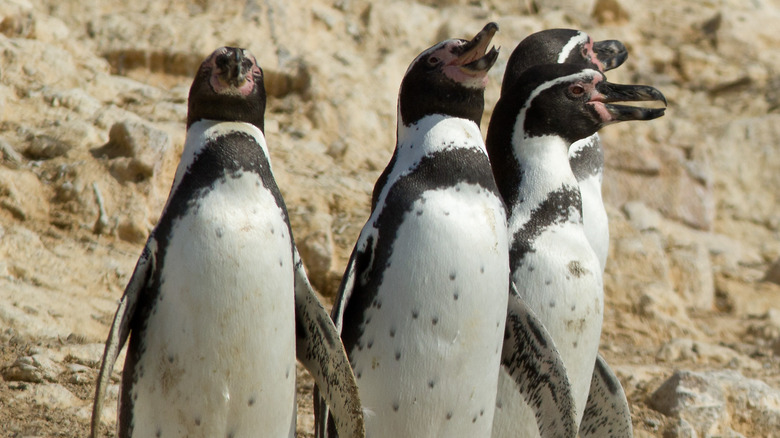
Sue Bishop/Shutterstock
Visitors to Peru can take a speedboat to the Ballestas Islands, which are considered a “mini-Galápagos” due to their location and unique wildlife. In addition to thousands of sea lions, these rocks are home to a group of Humboldt penguins, small birds weighing roughly 9 to 11 pounds. They live all along the coast of Peru and the north of Chile.
Since these islands are federally protected areas, tourists cannot simply walk onto the islands to see the penguins up close. Swimming with them is also prohibited. You’ll have to settle for views from your seat in the boat. Be sure to bring a wind jacket, hat, and sunscreen for protection from the elements.
To get to the Ballestas, drive or take a bus to Paracas, where you can find daily boat tours. Depending on traffic, Paracas is about 3 or 4 hours south of Peru’s capital city of Lima. Most of the boat tours begin by 10 a.m., so plan to drive down very early in the day or get there the night before.
Punta Tombo, Argentina
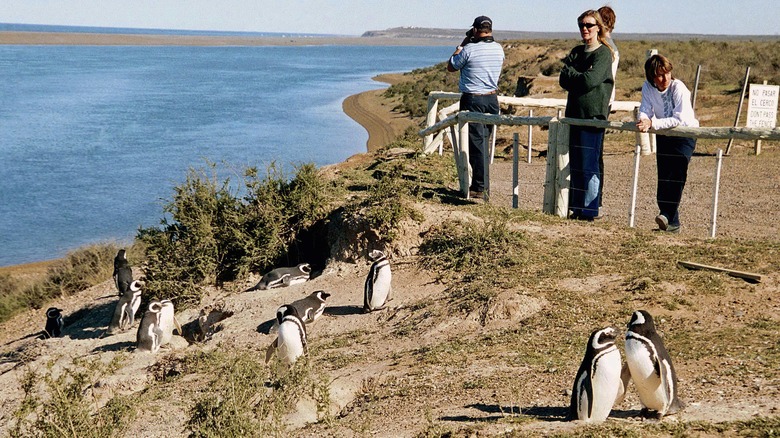
Bloomberg/Getty Images
Around 500,000 Magellanic penguins come to the Punta Tombo nature reserve every year, according to U.S. News & World Report. These penguins were named after Ferdinand Magellan, the explorer credited with leading the first voyage around the world. Penguins International reports that Magellan saw these penguins in 1520 when he sailed around the tip of South America.
Located 68 miles from the city of Trelew, Punta Tombo is reachable by car. To get to Trelew, you’d need to fly to Buenos Aires first and then take a flight to Trelew International Airport. Alternately, you can find day trips to Punta Tombo from the coastal city of Puerto Madryn, a common port for cruise ships in Patagonia.
Magellanic penguins build burrows in the dirt for their nests, so visitors to Punta Tombo who walk on the boardwalks and designated trails will see a lot of holes in the soil. The park has several trails which can occupy visitors for hours. You may even see guanacos wander through the area from September to March. If you make a trip to Punta Tombo, it’s also worth visiting Península Valdés, just north of Puerto Madryn. Smaller numbers of Magellanic penguins live there, along with other marine animals, including elephant seals and sea lions.
Parque Pinguino Rey, Chile
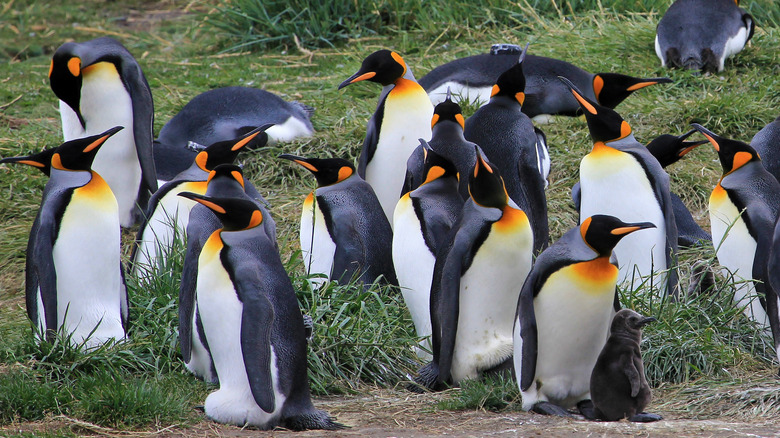
reisegraf.ch/Shutterstock
Seeing penguins in Chile requires a bit of effort. The country has a lot of islands and coastal areas packed with penguins, but many are difficult to reach. One possible option is the Humboldt Penguin National Reserve, which is about a seven-hour drive from the capital city of Santiago.
For a different experience, tourists may want to consider visiting Parque Pinguino Rey, or “King Penguin Park.” Open from October to May, the park lies near the southern tip of Chile, in the Punta Arenas area. Reservations are recommended since the park limits the number of daily visitors. From Santiago, you can fly to Presidente Carlos Ibáñez International Airport in Punta Arenas. The drive from there is about four hours. Or you can take a guided one-day tour from Punta Arenas.
According to Chile Travel, this colony of king penguins only arrived here in 2010, prompting the creation of the sanctuary. While it’s not possible to see the famous emperor penguins anywhere outside of Antarctica, the king penguins found here are similar in a lot of ways. King penguins are a little smaller, but, like emperors, they have plain white chests with yellow-orange patches on their neck, throat, and beak. Neither emperor nor king penguins build nests; instead, they incubate eggs by holding them on top of their feet.
Oamaru, New Zealand
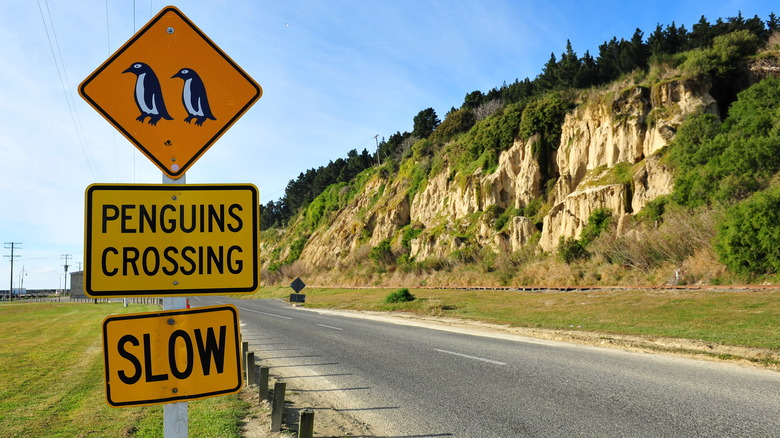
Jordan Tan/Shutterstock
The town of Oamaru is a great place to see two different types of penguins — yellow-eyed penguins, and little penguins, also known as blue penguins. Weighing under 3 pounds and standing about 12 inches tall, little penguins fully live up (or down?) to their name. They have blue eyes and blue-gray feathers, setting them apart from many other penguin species. Oamaru Blue Penguin Colony has set up a grandstand and viewing area where visitors can reserve seats to watch the birds as they waddle in from shore just after dark following a long day of fishing. This site doesn’t permit photography, and its ticket prices go to support conservation efforts.
Google reviewers note that they often see little penguins outside the viewing area, in parking lots, and nearby areas of Friendly Bay. So, if you want to snap some photos and observe these cute critters away from the throngs of tourists, head to the public areas of the bay.
Visitors can find endangered yellow-eyed penguins at Bushy Beach. Penguins International says yellow-eyed penguins are one of the world’s rarest penguins, with only 1,700 breeding pairs in the wild. Bushy Beach Track is a walking trail atop a cliff that provides views of the birds as they walk on the beach below. Come before 9 a.m. or after 3 p.m., as the penguins prefer to spend most of the day in the ocean.
Stewart Island, New Zealand
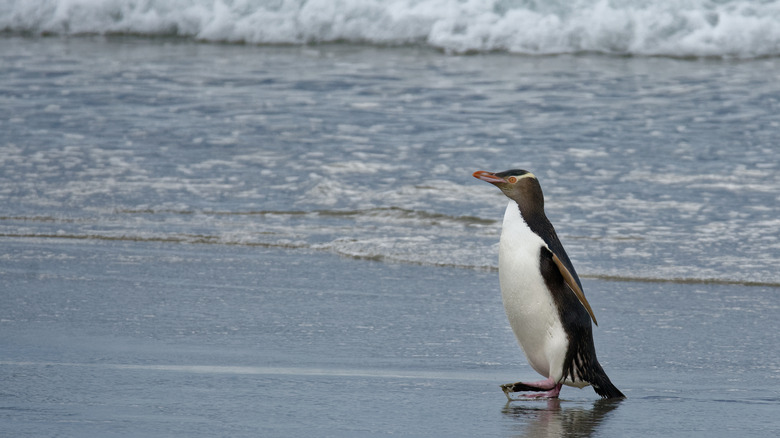
Martin Pelanek/Shutterstock
Travelers to New Zealand should consider visiting Stewart Island, a paradise for wildlife. Roughly 85% of Stewart Island is part of Rakiura National Park, where yellow-eyed penguins, little penguins, and even Fiordland penguins live, along with the famous New Zealand kiwis. Located 18 miles south of the mainland and accessible by ferry from the town of Bluff, Stewart Island has numerous walking and hiking trails for visitors who love nature.
The travel blog Walk My World recommends the Oban jetty and the Ackers Point observation deck as some of the best spots to see little penguins on the island. Fiordland penguins are more challenging to find here, as many live in areas that are inaccessible to humans. A survey of the birds a few years ago revealed about 100 breeding pairs of Fiordland penguins living in caves on the rocky coastlines of Stewart Island, with the highest density found around Little Bungaree Beach. Yellow-eyed penguins are infrequently seen on the island, but from Stewart Island, you can take another ferry or organized tour to an even smaller island, Ulva Island, where the yellow-eyed birds are more common.
While there’s no aurora borealis in this part of the world, there is aurora australis — the southern lights! NZ Pocket Guide notes that Stewart Island is a fantastic place to potentially see the southern lights, especially if you visit during June or July.
Melbourne, Australia
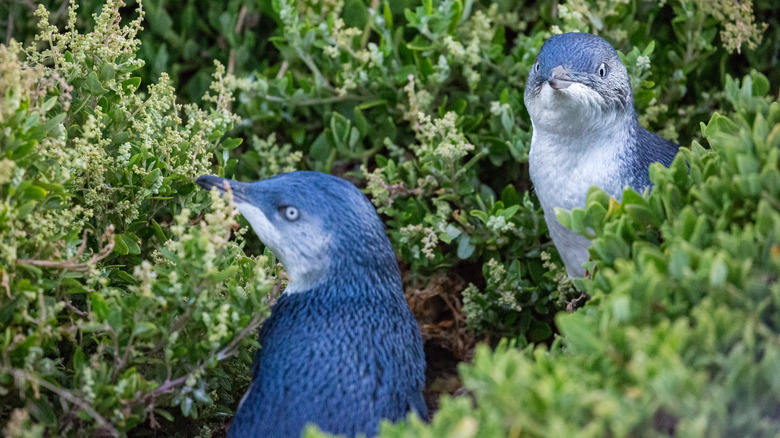
Goddard_photography/Getty Images
Australia has several places to see penguins, some in close proximity to major cities. The Melbourne suburb of St. Kilda has a colony of little penguins that visitors see regularly at the St. Kilda Pier, just a short walk from hotels, highways, parking garages, and other elements of urban life. Around 1,400 penguins live in the area, and they can be seen every day after sunset when they emerge from the water. It’s uncommon to see penguins so close to any major city, especially for free. That makes visiting the pier one of the best budget-friendly activities in Melbourne.
Another ideal place to see little penguins requires a slightly longer drive from Melbourne, about two hours down to Phillip Island. The isle is connected to mainland Australia via a bridge, so it’s easily accessible. The nightly viewing is referred to as the “Penguin Parade” because thousands of little penguins march ashore nightly on Summerland Beach to head to their burrows. Phillip Island Nature Parks operates the site, and visitors must purchase a ticket to use the boardwalk and viewing platforms.
Penguin Island, Australia
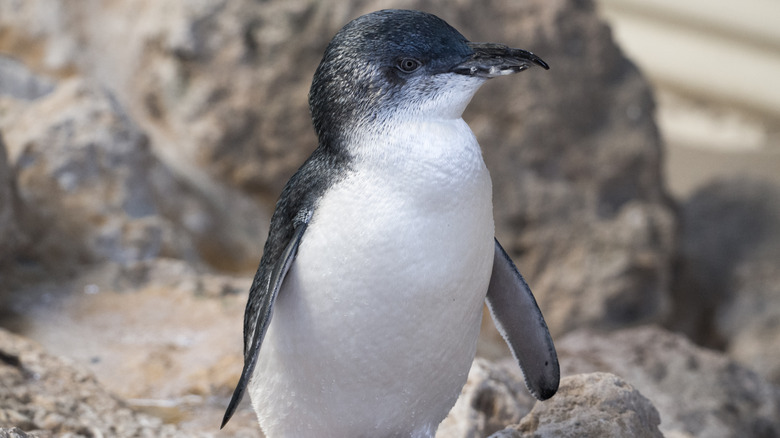
Emma Jones/Shutterstock
Located near Perth, Penguin Island has the largest colony of little penguins in Western Australia. But much like Glacier National Park, Penguin Island is in danger of losing the very thing for which it’s named. Estimates suggest that the park has seen a decline of more than 80% in the population of little penguins since 2007, due mainly to boat strikes and warming temperatures. Local wildlife organizations have been working to reverse this trend.
The island is small, and visitors can expect to see lots of penguin burrows, though the birds themselves may be out swimming during the day. Ferries from the suburb of Shoalwater to Penguin Island leave every hour from 9 a.m. to 3 p.m., so travelers can easily work a visit to the island into their schedules.
For an extra $10, the ferry company, Perth Wildlife Encounters, offers an add-on with a guided walking tour of the island. The ferry does not operate from early June to mid-October when the island is closed to visitors to allow the penguins to breed in peace. A conservation policy announced by Australia’s Minister for Environment also closes Penguin Island when temperatures are predicted to be 95 degrees Fahrenheit or higher.
Falkland Islands
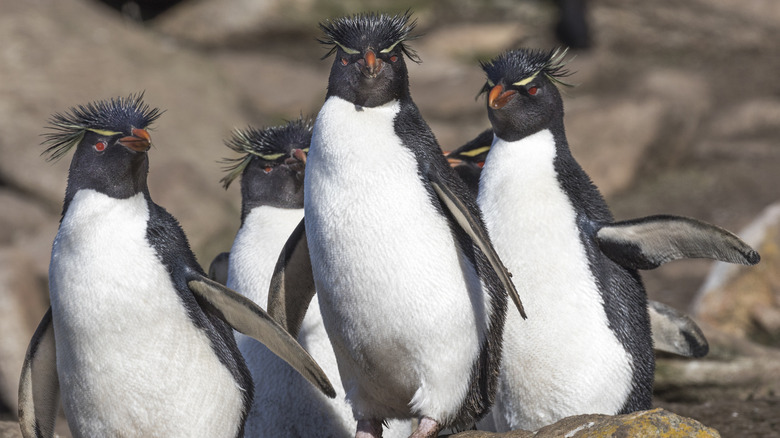
Ag-chapelhill/Getty Images
The Falkland Islands sit some 300 miles east of the southern tip of Argentina. Only the most dedicated tourists can make their way here due to the limited availability of flights. Falkland Islands Tourism says that public international flights are available from two locations in South America: Santiago, Chile, and Sâo Paulo, Brazil. The reward for coming is a chance to find five different kinds of penguins, including species not found in most other places. The Falklands are home to rockhopper, gentoo, macaroni, Magellanic, and king penguins.
Bluff Cove Lagoon is a privately-owned sheep farm with guided tours that allow guests to see hundreds of gentoo penguins, which stand out with their bright yellow beaks and feet. Magellanic penguins can be found at Gypsy Cove, just a few miles from the airport in the capital city of Stanley. Farther north, Volunteer Point harbors a large colony of king penguins.
Macaroni and rockhopper penguins are similar, as both have golden plumes above their eyes and often nest together near seaside cliffs. These penguins are harder to find, as they leave the islands during winter and tend to nest in more inaccessible parts of the Falklands in the summer. Rockhoppers are common on the Jason Islands, which can be reached by boat. Visitors eager to see rockhoppers may want to contact the islands’ primary tour operator to create a custom itinerary.
Methodology
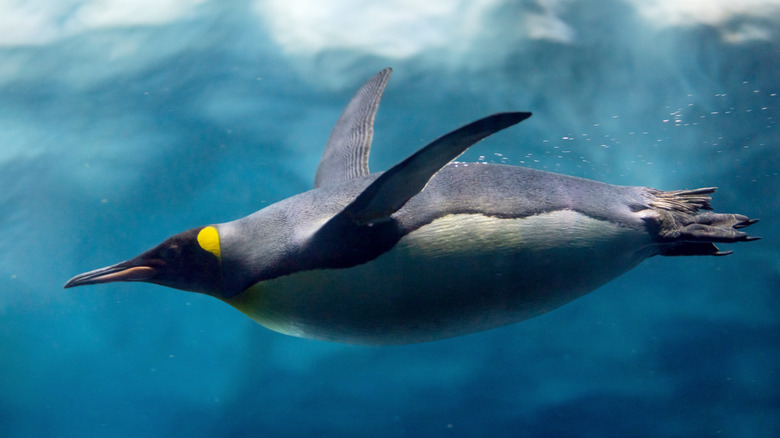
David Herraez Calzada/Shutterstock
For this article, we considered all the places in the world where penguins are found outside of the obvious location of Antarctica. We tried to choose destinations where it was feasible for tourists to visit without too much hassle based on the information found on the websites of wildlife organizations, local municipalities, and local tourism boards.
We decided not to feature places that require too much effort to visit for the average tourist, such as the remote island of South Georgia, which is mainly visited by passengers on Antarctic cruises.

